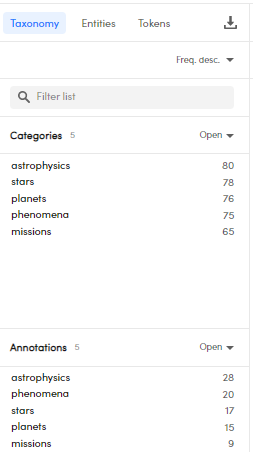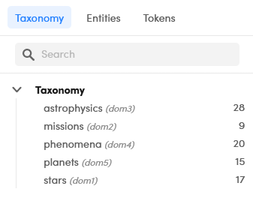The Documents tab
Below you will find the peculiarities of the Documents tab of the project dashboard of categorization projects.
The characteristics of the tab that are common to all project types are described in the article dedicated to the topic.
Sort the document list
In addition to the sorting options common with other project types, the Categories sorting option available in the list view of the Documents tab, in the context of an experiment, allows you to sort the list of documents based on the number of output categories.
Categories
Annotated categories and—when in the context of an experiment—output categories are displayed:
-
In list view: below the document abstract.

-
In detail view: above the document text, that is in the fourth bar from the top of the central panel or in the second bar if immersive view or PDF document view is turned on.

In the default visualization of the detail view, the number of output categories and the number of categories annotated is also shown in the third bar from the top of the central panel, together with annotation buttons.

The Taxonomy tab
In list view
In list view, the Taxonomy tab is displayed in the left panel.
If an experiment is selected, under Categories you'll find the categories that were detected by the experiment model.
Under Annotations are listed the categories that were annotated as expected results.

The numbers beside the Categories and Annotations headings are, respectively, the number of distinct categories detected by the experiment model and the number of distinct categories that have been annotated in the current, possibly filtered, set of documents.
The number beside each category under Categories is the number of documents in the current list in which that category was detected by the experiment model. Similarly, the number beside each category under Annotations is the number of documents in which that category was annotated.
Note
Outside the scope of an experiment, if there are no annotations no information is displayed in the tab.
- To filter the lists, type a value or the initial part of it in the Filter list box and press
Enter. The match is case sensitive. Select the X icon inside the box to cancel the filter. - To change the sort order, select the desired option from the drop-down menu at the top right of the list.
- Double-click an item to insert it in the search bar as criteria for document search.
If a list appears truncated, select Open beside its name to give the list maximum space. Select Close to revert to previous visualization.
- To switch to the Resources tab of the project dashboard and show the detail of a category, select or hover over the category and select Show in resources
 .
. - To show more information about a category, select or hover over it and select Show info
 .
.
In detail view
In detail view, the Taxonomy tab on the right shows the project taxonomy.

The number to the right of the category is the number of documents in which the category has been annotated as the expected result.
Within the tab you can:
- Expand and collapse the nodes.
- Search for categories in the taxonomy.
- Filter documents by category.
- Filter documents by annotation.
-
Switch to the Resources tab of the project dashboard and show the detail of a category:
- Select or hover over the category under Taxonomy in the Taxonomy tab of the left panel.
- Select Show resources
 .
.
The right panel in list view
In the list view the Resources panel on the right shows the project taxonomy.

Select Expand  and Collapse
and Collapse  to expand and collapse the panel.
to expand and collapse the panel.
The number to the right of the category is the number of documents in which the category has been annotated as the expected result.
The colored dot beside the number is:
 red if there are less than six documents in which the category has been annotated.
red if there are less than six documents in which the category has been annotated. yellow if there are between six and 20 documents in which the category has been annotated.
yellow if there are between six and 20 documents in which the category has been annotated.
There is no colored dot if there are more than 20 documents in which the category has been annotated.
The actions you can perform within the panel are the same available in the Taxonomy tab of the detail view (see above).
Manage annotations
In categorization projects, both the list view and detail view of the Documents tab have numerous controls for annotating categories and sections.
Segments
Segments are block of text identified by specific rules in Studio projects.
Segments are part of the output of experiments based on CPK models imported from Studio. When detected, they are listed under the Tokens tab, which is inside the left panel in list view and inside the right panel in detail view.

Sections
In the detail view and its variants you can toggle the display of sections. To do this, use the Toggle sections  toggle switch on the toolbar next to the document name. The button is enabled only if sections have been defined.
toggle switch on the toolbar next to the document name. The button is enabled only if sections have been defined.

In the absence of explicit annotations, all text belongs to the standard section.
In the dedicated article you will find information on how to annotate sections.
Create a new category
When in detail view, to create a new category using a portion of the text of the document as the category name (which you can later change):
- Select the portion of text corresponding to the category name. A pop-up menu will appear.
- Select Create category. The New category dialog will appear.
- To create broader or narrower categories do as described in the article about editing the taxonomy.
The project taxonomy will be accordingly updated.
Open a document in Studio
It is possible to open a Platform document directly in Studio.
Note
Make sure to have the latest available Studio version.
To do it, if you do not have any linked projects:
- Open Studio and connect to the Platform.
- In the View Platform Projects window, link your Studio project module with your Platform project.
-
Open the Platform document in detail view and select Open document in Studio
 . A pop-up menu will ask you to open Studio.
. A pop-up menu will ask you to open Studio.Warning
You cannot open a document in Studio from Platform unless you link your Platform project to your Studio project as described in step 2.
The document will be prepared and then opened in the Studio editor and an analyzed will be automatically performed.
If you linked a Studio project to a Platform project and then you close Studio at a later time, simply repeat step 3 as described above. Studio will automatically open and login to the Platform.
Note
Even if you open Studio without connecting to the Platform, repeat step 3. In this case, Studio will only login to the Platform automatically.
If you open a document from Platform that has already been prepared, opened and analyzed in Studio, a dialog will ask you to overwrite the document.
If the document you opened in Studio has annotations and resulting categories obtained while working on Platform, check the Categories tab of the Annotation tool window to check the categories. The category ID you see in the Resources tab of both annotations and resulting categories is reported.
Note
All annotations will be stored in the ann folder in Studio.
If you have Studio closed, you never linked your Platform and Studio projects and select Open document in Studio  , the same pop-up menu will appear as described above in step 3 and also another warning telling you to link your projects. Select OK. Studio will then open automatically.
, the same pop-up menu will appear as described above in step 3 and also another warning telling you to link your projects. Select OK. Studio will then open automatically.